|
Week 11: October 10 - 16, 2012 |
Welcome
to the McGill Bird Observatory weekly report.
Click here for a complete listing of our archives.
Comments or
questions are welcome at "mbo AT migrationresearch.org".
|
PICTURE
OF THE WEEK: |
|
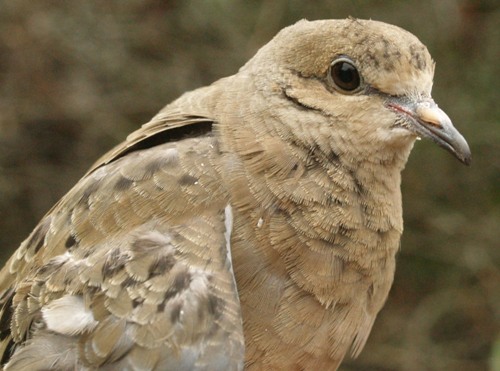
Although we see Mourning Doves almost daily in fall, and have over the years banded
43 of them in winter and one in spring, the one above was the first one ever
banded as part of the Fall Migration Monitoring Program.
(Photo by Simon Duval)
-
|
|
|
THIS WEEK |
THIS FALL |
2012 TOTAL |
SITE TOTAL |
|
# birds (and species) banded |
316 (26) |
3580 (82) |
4845 (88) |
40596 (108) |
|
# birds (and species) repeat |
148 (16) |
948 (49) |
1286 (59) |
7699 (70) |
|
# birds (and species) return |
6 (4) |
75 (21) |
214 (28) |
1175 (38) |
|
# species observed |
59 |
141 |
165 |
207 |
|
# net hours |
479.0 |
5830.3 |
9090.1 |
68189.2 |
|
# birds banded / 100 net hours |
66.0 |
61.4 |
53.3 |
59.5 |
|
|
Note: table does not include nocturnal banding (owls) |
|
Banders-in-charge: Bob Barnhurst, Simon Duval, Gay Gruner
Assistants: Nicolas Bernier, Marc Boisvert, Cindy Bouchard, Chantal Cloutier, David Davey, Jean Demers, Tammy Elliott, Louise Gagné, Jo-Annie Gagnon, Tiffany Gilchrist, Monique Groulx, Alison Hackney, Lisa Keelty, Shelley Kirk, Barbara and Don MacDuff, Francine Marcoux, Betsy McFarlane, Charla Patterson, Benoit Piquette, Geneviève Potvin, Clémence Soulard, Alex Stone, Patricia Stotland, Rodger Titman, Carine Touma, Monique Venne
Notes: Again, what a difference a week makes. Last week we had by far our busiest week of fall, and this week the number of birds banded dropped by well over half, although to a large extent the species mix remained similar. The number of birds banded this week was slightly below the seven-year average of 340 for week 11, but our cumulative total of 3580 this fall remains far ahead of all previous years except 2008 and 2010. Another noticeable drop this week was in species diversity, down a full 20 species from last week's count of 79, and actually a bit below the long-term average of 61 for this part of the season. However, numbers were fairly steady throughout the week, ranging from 36 to 44 species observed daily, and between 33 and 51 birds banded, except for a higher count of 67 on the first day of the week. With another 148 repeats this week, we have already set a new season record in this category, and will almost certainly pass the 1000 mark before fall is over. The record number of returns also continues to climb, now standing at 75 for the season.
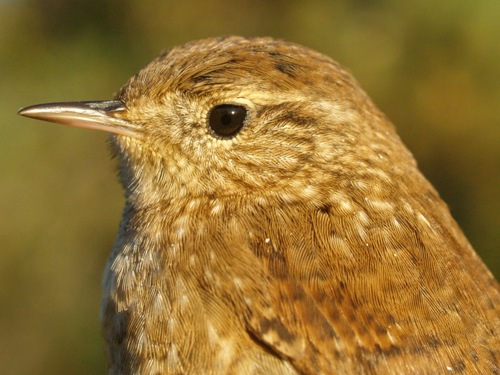
Only our third Winter Wren of the season, posing nicely in the morning light.
(Photos by
Simon Duval)
|
As noted last week, additions to the seasonal species lists become more difficult once we get into October. Sure enough, American Tree Sparrow was the only new species to arrive this week. It was also one of two species banded for the first time this fall, along with the Mourning Dove featured at the top of this week's report. That brings the number of species banded at MBO this fall to 82, a new record. This week we also had our first Slate-colored Junco return of 2012, as well as our first fall Fox Sparrow repeat. One of the two junco returns was particularly noteworthy, as we banded it on 27 October 2008, recaptured it twice in November 2009, but haven't seen it between then and now.
This week’s top 10 [last week's rank in brackets]
# individuals banded |
mean # individuals observed daily |
1. Ruby-crowned Kinglet (56) [2] |
1. Common Grackle (377) [1] |
2. White-throated Sparrow (55) [3] |
2. Red-winged Blackbird (347) [3] |
3. Slate-colored Junco (43) [4] |
3. Canada Goose (297) [2] |
4. Hermit Thrush (32) [5] |
4. American Robin (213) [6] |
5. American Robin (29) [8] |
5. European Starling (133) [4] |
6. Yellow-rumped Warbler (21) [1] |
6. American Crow (84) [9] |
7. Fox Sparrow (12) [-] |
7. White-throated Sparrow (58) [5] |
8. Purple Finch (10) [-] |
8. Slate-colored Junco (45) [7] |
9. Black-capped Chickadee (8) [-] |
9. Ruby-crowned Kinglet (20) [10] |
9. Golden-crowned Kinglet (8) [7]
9. Song Sparrow (8) [8]
|
10. Black-capped Chickadee (19) [-] |
|
The peak in Yellow-rumped Warbler migration was short and modest this year, with only 21 more banded this week, bringing the season total to 290 - almost three times as many as in the average "low year", but less than one-quarter as many as in an average "high year". While that species fell to sixth place this week, the rest of last week's top five each shifted up one position, with Ruby-crowned Kinglet narrowly beating out White-throated Sparrow for top spot. Ruby-crowned Kinglet was previously the week 11 champion in 2007, whereas White-throated Sparrows are typically past their peak by mid-October, with the count in all previous years ranging from 10 to 41. However, this is proving to be an exceptional year for the species, with this week's additions bringing the season total to 476, well beyond the previous fall record of 428 in 2009. Juncos are often among the top five species banded in week 11, and there may yet be many more to come. Like all its other close relatives, Hermit Thrush seems to be on pace for a record season, with 80 so far this fall, compared to a high count of 90 in 2010. We have often had more American Robins in week 11, ranging as high as 103 in 2008, but there seem to be good numbers in the area and we may still band more in the final two weeks of the fall season. Similarly, Fox Sparrows are increasing but may not yet have reached their peak. For the eighth week in a row we banded Purple Finches, and 10 is the highest count we've had yet in a week, bringing the season total to 42. Banding stations in Ontario are reporting even larger influxes of both Purple Finches and Black-capped Chickadees, but we seem to be on the margins of these movements, suggesting perhaps that it's more reflective of something happening in Ontario, rather than the Quebec-Labrador peninsula.
Although the count of birds banded this week dropped off substantially, the number observed remained similarly high, with nine of the species in this week's top ten holdovers from week 10, the only difference being Black-capped Chickadee replacing Yellow-rumped Warbler. Common Grackle remained the most abundant species for the second week in a row, marking the first time in our eight year history that week 11 was not dominated by either Canada Goose or American Robin. Also beating out that traditional duo this year was Red-winged Blackbird, which has now been the runner-up in week 11 for four of the past five years. Mixed in with the grackles and blackbirds again this week were large flocks of European Starlings, and another black bird, i.e. American Crow, rounded out the top six. From there it was a fairly big drop to the dominant sparrows of the week, White-throated Sparrow and Slate-colored Junco, and then another large step down to Ruby-crowned Kinglet and Black-capped Chickadee.
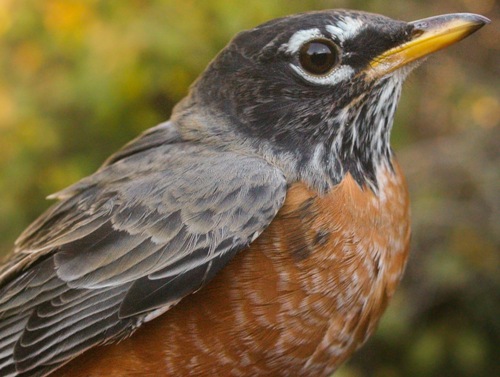
Robin season is upon us again! Many people see them as a sign of spring, but at MBO, they are never more common than in October.
(Photo by
Simon Duval)
|
The week started off slowly for owl banding, with none the first night, and rain washing out the second. As is often the case, the night following rain was productive, with 17 new Saw-whet Owls, plus a recapture of one banded in New York. The next three nights were a bit quieter, ranging from 1 to 7 owls per night, but the best was yet to come. On October 16, we matched our single-night record (set last year on October 22) with 30 saw-whets, bringing our total for the week to 57, and for the season to 140.
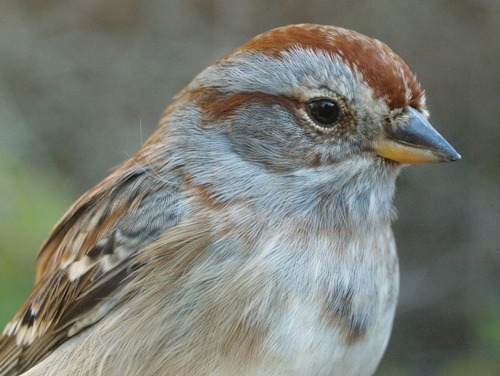
One of just two American Tree Sparrows banded so far this fall, but this is a species that almost always peaks in the final week of the Fall Migration Monitoring Program, so we are certain that more are on their way.
(Photo by
Simon Duval) |
It was hard not to think this week that migration seems to be winding down a bit already. However, the skies were still filled with blackbirds and robins by the hundreds, there are plenty of sparrows yet to come, and we may yet still see a bit more Black-capped Chickadee and Purple Finch action. Two more weeks to go!
|
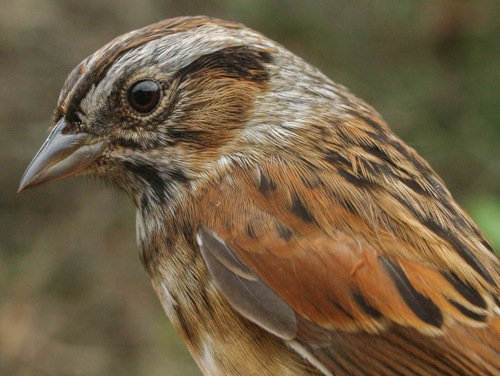
Among the many "brown birds" dominating the nets recently, Swamp Sparrows have not been abundant enough to draw a lot of attention, but 16 birds over the past two weeks is nonetheless a bit above average for this species, even though weeks 10 and 11 are their typical peak of migration. The photo below illustrates particularly well how elongated the bill is compared to most other sparrows.
(Photo above by Simon Duval, below by Gay Gruner)
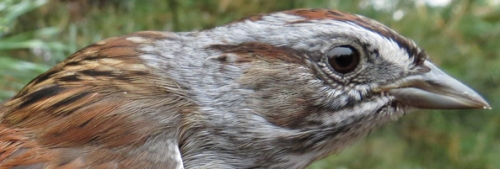
|






